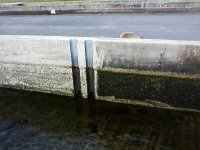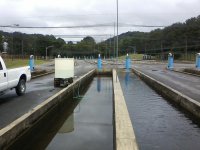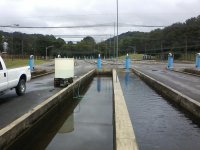I'm looking for an easy, quick, efficient way for our team at a fish hatchery to pressure wash (to remove stubborn, grown-on, green algae) from the walls and floor of concrete, empty fish raceways on a regular basis (once or twice per year) before we put the next cycle of trout in them. We have 104 of these raceways. Getting them done quickly and with as few people as possible is important, because we often have to wait on the PWing in order to start moving the fish. So if we could do this quicker than we're doing it now, we could stay caught up better. We don't go for perfection. We try to get most of the algae off below the water line without removing much concrete or sand from the walls and floor. Above the water line, we spray the walls and tops off to make them look better.
When we wash them down, there is a little water running along the floor that gets deeper as we move towards the lower end. At the upper end, it varies from about 1/4 to 1/2 inch deep, but on the lower end, it maybe up to 2 1/2" deep, and this makes it harder and slower to clean the floor as we move towards the lower end where there is a drain that goes to our effluent system. We don't have a way to completely stop the flow of an empty raceway from incoming water, so, in a way, this is helpful, because it gives us some extra rinsing power to keep the dirty water going down the drain, because we have a grade of 6" drop for every 100'. But in another way, when the water gets deeper on the lower end, the dirty water tends to swirl and it's hard to see, and the deeper water slows us down alot.
Currently, we use two, 2.4 gpm, 3,000 psi, Mi-T-M pressure washers. It takes us about 2 hrs for one raceway, using both of these, including set up time and all. It takes almost 4 hrs (average) to do one with one pressure washer. We got some money at the end of the year, and I talked the boss in to letting us get a higher gpm pressure washer, as I've been doing research on them trying to figure out a way to make this a faster process. We've got a 3.7 gpm, belt drive coming. I feel like that the more gpm we could get, the faster we could do these jobs, but the supervisors are not totally convinced. They worry about over power and stripping the concrete, but I contend that if we have more power, we can simply move the tip farther away; get larger swaths; and do the jobs quicker. The 3.7 was all I could get out of the boss, and hopefully, I can show everyone how this higher gpm will help us do the work more productively. So I guess one could say that I didn't win the debate, but that we got to some sort of compromise.
Another big limitation for us is our current set up. We have no pressurized water supply, because our raceways are too far away from the water spickets. Currently, we fill up a 350 gallon water tank that is either loaded on a 1-ton pickup or on a 4-stack of pallets and then we move the water with the truck or a fork lift; and then, in the case of the fork lift, we have to drive back up to our buildings and load the pressure washers and other equipment, drive back down to the raceways, set up, and then pressure wash. When we finish that raceway, we have to do it all over again to start the next raceway. In the case of the pickup, we can keep the pressure washers on the pickup, which was an idea I recently came up with that works well and makes things much quicker, however, we've found that we can't keep that pickup dedicated to this task, and we also found that it takes alot more strapping and securing to keep the tank and pressure washers in place. In the case of the fork lift, sometimes it is being used moving fish at the same time that we're trying to pressure wash, so we have to use it for double duty and that slows both processes. Filling the tank with city water takes about 1 hr. We have a pump to fill the tank with lake water, and we've done that for years, but our supervisor suddenly decided after we started having trouble with our 1 1/2 yr old, consumer-grade pressure washers with a 1,000 hrs a piece on them, that the lake water was causing our problems even though the inlet screen has not been clogging.
I've got this idea, since we are limited on heavy-duty vehicles and moving a large tank of water requires a heavy-duty vehicle, that if we could some how tap into our adjacent raceway of lake water via a pump where the stream is about 15" deep and continually fill a smaller tank, i.e. 50 gallon tank with on-off floats and some sort of demand pump and filter system. In this scenario, we would have an unlimited supply of water and we could simply use a cushman with the pressure washer loaded on it to move around from raceway to raceway. So here is the dilemma and the area in which I need help from someone who knows about such things. How can we pump water up about 6' from a moving stream on a continual basis, across about 25', into a tank, and have an auto shutoff float. Or alternatively, we could continuously pump the water and have an over-flow tube send the water back into the adjacent raceway. Or alternatively, we could use a demand pump plumbed directly to the inlet of the pressure washer, however, I don't know what kind of pumps will do what, and I don't know how to filter the lake water to keep from damaging the pressure washer pump. And I don't know if what I'm envisioning is something we can do. And I don't know how big a deal it is to have perfectly clean water going towards the inlet side of the pump. We need the pump to be 12 volt to run off the cushman battery or a dedicated, mobile battery.
Any brainstorming, ideas, suggestions, critiques, experiences would be very helpful to make us better!
When we wash them down, there is a little water running along the floor that gets deeper as we move towards the lower end. At the upper end, it varies from about 1/4 to 1/2 inch deep, but on the lower end, it maybe up to 2 1/2" deep, and this makes it harder and slower to clean the floor as we move towards the lower end where there is a drain that goes to our effluent system. We don't have a way to completely stop the flow of an empty raceway from incoming water, so, in a way, this is helpful, because it gives us some extra rinsing power to keep the dirty water going down the drain, because we have a grade of 6" drop for every 100'. But in another way, when the water gets deeper on the lower end, the dirty water tends to swirl and it's hard to see, and the deeper water slows us down alot.
Currently, we use two, 2.4 gpm, 3,000 psi, Mi-T-M pressure washers. It takes us about 2 hrs for one raceway, using both of these, including set up time and all. It takes almost 4 hrs (average) to do one with one pressure washer. We got some money at the end of the year, and I talked the boss in to letting us get a higher gpm pressure washer, as I've been doing research on them trying to figure out a way to make this a faster process. We've got a 3.7 gpm, belt drive coming. I feel like that the more gpm we could get, the faster we could do these jobs, but the supervisors are not totally convinced. They worry about over power and stripping the concrete, but I contend that if we have more power, we can simply move the tip farther away; get larger swaths; and do the jobs quicker. The 3.7 was all I could get out of the boss, and hopefully, I can show everyone how this higher gpm will help us do the work more productively. So I guess one could say that I didn't win the debate, but that we got to some sort of compromise.
Another big limitation for us is our current set up. We have no pressurized water supply, because our raceways are too far away from the water spickets. Currently, we fill up a 350 gallon water tank that is either loaded on a 1-ton pickup or on a 4-stack of pallets and then we move the water with the truck or a fork lift; and then, in the case of the fork lift, we have to drive back up to our buildings and load the pressure washers and other equipment, drive back down to the raceways, set up, and then pressure wash. When we finish that raceway, we have to do it all over again to start the next raceway. In the case of the pickup, we can keep the pressure washers on the pickup, which was an idea I recently came up with that works well and makes things much quicker, however, we've found that we can't keep that pickup dedicated to this task, and we also found that it takes alot more strapping and securing to keep the tank and pressure washers in place. In the case of the fork lift, sometimes it is being used moving fish at the same time that we're trying to pressure wash, so we have to use it for double duty and that slows both processes. Filling the tank with city water takes about 1 hr. We have a pump to fill the tank with lake water, and we've done that for years, but our supervisor suddenly decided after we started having trouble with our 1 1/2 yr old, consumer-grade pressure washers with a 1,000 hrs a piece on them, that the lake water was causing our problems even though the inlet screen has not been clogging.
I've got this idea, since we are limited on heavy-duty vehicles and moving a large tank of water requires a heavy-duty vehicle, that if we could some how tap into our adjacent raceway of lake water via a pump where the stream is about 15" deep and continually fill a smaller tank, i.e. 50 gallon tank with on-off floats and some sort of demand pump and filter system. In this scenario, we would have an unlimited supply of water and we could simply use a cushman with the pressure washer loaded on it to move around from raceway to raceway. So here is the dilemma and the area in which I need help from someone who knows about such things. How can we pump water up about 6' from a moving stream on a continual basis, across about 25', into a tank, and have an auto shutoff float. Or alternatively, we could continuously pump the water and have an over-flow tube send the water back into the adjacent raceway. Or alternatively, we could use a demand pump plumbed directly to the inlet of the pressure washer, however, I don't know what kind of pumps will do what, and I don't know how to filter the lake water to keep from damaging the pressure washer pump. And I don't know if what I'm envisioning is something we can do. And I don't know how big a deal it is to have perfectly clean water going towards the inlet side of the pump. We need the pump to be 12 volt to run off the cushman battery or a dedicated, mobile battery.
Any brainstorming, ideas, suggestions, critiques, experiences would be very helpful to make us better!




